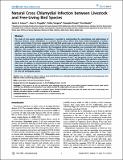Por favor, use este identificador para citar o enlazar a este item:
http://hdl.handle.net/10261/126608COMPARTIR / EXPORTAR:
 SHARE SHARE
 CORE
BASE CORE
BASE
|
|
| Visualizar otros formatos: MARC | Dublin Core | RDF | ORE | MODS | METS | DIDL | DATACITE | |

| Título: | Natural cross chlamydial infection between livestock and free-living bird species |
Autor: | Lemus, Jesus A.; Fargallo, Juan A. CSIC ORCID ; Vergara, Pablo CSIC; Parejo, Deseada CSIC ORCID ; Banda, Eva | Fecha de publicación: | 19-oct-2010 | Editor: | Public Library of Science | Citación: | PLoS ONE 5 (10): e13512 (2010) | Resumen: | The study of cross-species pathogen transmission is essential to understanding the epizootiology and epidemiology of infectious diseases. Avian chlamydiosis is a zoonotic disease whose effects have been mainly investigated in humans, poultry and pet birds. It has been suggested that wild bird species play an important role as reservoirs for this disease. During a comparative health status survey in common (Falco tinnunculus) and lesser (Falco naumanni) kestrel populations in Spain, acute gammapathies were detected. We investigated whether gammapathies were associated with Chlamydiaceae infections. We recorded the prevalence of different Chlamydiaceae species in nestlings of both kestrel species in three different study areas. Chlamydophila psittaci serovar I (or Chlamydophila abortus), an ovine pathogen causing late-term abortions, was isolated from all the nestlings of both kestrel species in one of the three studied areas, a location with extensive ovine livestock enzootic of this atypical bacteria and where gammapathies were recorded. Serovar and genetic cluster analysis of the kestrel isolates from this area showed serovars A and C and the genetic cluster 1 and were different than those isolated from the other two areas. The serovar I in this area was also isolated from sheep abortions, sheep faeces, sheep stable dust, nest dust of both kestrel species, carrion beetles (Silphidae) and Orthoptera. This fact was not observed in other areas. In addition, we found kestrels to be infected by Chlamydia suis and Chlamydia muridarum, the first time these have been detected in birds. Our study evidences a pathogen transmission from ruminants to birds, highlighting the importance of this potential and unexplored mechanism of infection in an ecological context. On the other hand, it is reported a pathogen transmission from livestock to wildlife, revealing new and scarcely investigated anthropogenic threats for wild and endangered species. | Versión del editor: | http://dx.doi.org/10.1371/journal.pone.0013512 | URI: | http://hdl.handle.net/10261/126608 | DOI: | 10.1371/journal.pone.0013512 | E-ISSN: | 1932-6203 |
| Aparece en las colecciones: | (EEZA) Artículos |
Ficheros en este ítem:
| Fichero | Descripción | Tamaño | Formato | |
|---|---|---|---|---|
| PlosOne_Lemus.pdf | 411,86 kB | Adobe PDF |  Visualizar/Abrir |
CORE Recommender
PubMed Central
Citations
6
checked on 17-abr-2024
SCOPUSTM
Citations
20
checked on 16-abr-2024
WEB OF SCIENCETM
Citations
13
checked on 26-feb-2024
Page view(s)
303
checked on 21-abr-2024
Download(s)
240
checked on 21-abr-2024

